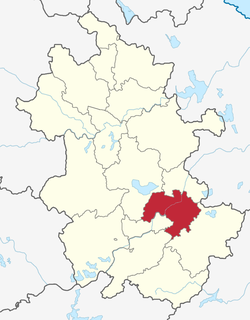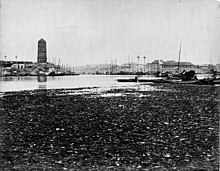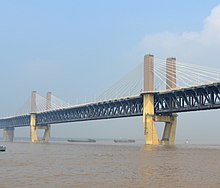world.wikisort.org - China
Wuhu (simplified Chinese: 芜湖; traditional Chinese: 蕪湖; pinyin: Wúhú; lit. 'Weedy Lake') is a prefecture-level city in southeastern Anhui province, China. Sitting on the southeast bank of the Yangtze River, Wuhu borders Xuancheng to the southeast, Chizhou and Tongling to the southwest, Hefei city to the northwest, Ma'anshan city to the northeast, Jiangsu Province to the east, and is approximately 90 km (56 mi) southwest of Nanjing. With the urbanization trend in the southern part of Nanjing, a conurbation between Nanjing, Maanshan and Wuhu is in building with more than 10,660,000 inhabitants.
This article needs additional citations for verification. (July 2012) |
Wuhu
芜湖市 | |
|---|---|
Prefecture-level city | |
 | |
 Location of Wuhu in Anhui | |
| Coordinates (Wuhu municipal government): 31°21′09″N 118°25′59″E | |
| Country | People's Republic of China |
| Province | Anhui |
| County-level divisions | 8 |
| Municipal seat | Jiujiang District |
| Government | |
| • Party Secretary | Pan Zhaohui (潘朝晖) |
| • Mayor | He Maoxie (贺懋燮) |
| Area | |
| • Prefecture-level city | 6,010.9 km2 (2,320.8 sq mi) |
| • Urban | 2,157 km2 (833 sq mi) |
| • Metro | 1,172.9 km2 (452.9 sq mi) |
| Elevation | 7.9 m (26 ft) |
| Population (2020 census)[1] | |
| • Prefecture-level city | 3,644,420 |
| • Density | 610/km2 (1,600/sq mi) |
| • Urban | 2,151,368 |
| • Urban density | 1,000/km2 (2,600/sq mi) |
| • Metro | 1,622,799 |
| • Metro density | 1,400/km2 (3,600/sq mi) |
| Time zone | UTC+8 (China Standard) |
| Area code | 0553 |
| ISO 3166 code | CN-AH-02 |
| GDP (2017) | ¥306.552 billion |
| GDP per capita | ¥82942 US$12284 |
| License Plate Prefix | 皖B |
| Website | www |
Administration
The prefecture-level city of Wuhu administers 8 county-level divisions, including 5 districts, 1 county, and 1 county-level city.[2]
| Name | Simplified Chinese | Pinyin | Population | Postal Code |
|---|---|---|---|---|
| Jinghu District | 镜湖区 | Jìnghú Qū | 478,658 | 241000 |
| Yijiang District | 弋江区 | Yìjiāng Qū | 422,620 | 241002 |
| Jiujiang District | 鸠江区 | Jiūjiāng Qū | 721,521 | 241000 |
| Wanzhi District | 湾沚区 | Wānzhǐ Qū | 344,016 | 241100 |
| Fanchang District | 繁昌区 | Fánchāng Qū | 243,907 | 241200 |
| Nanling County | 南陵县 | Nánlíng Xiàn | 431,148 | 241300 |
| Wuwei city | 无为市 | Wúwéi Shì | 817,997 | 238300 |
| Map |
|---|
- Defunct - Sanshan District
Geography
| Climate data for Wuhu (1981–2010 normals) | |||||||||||||
|---|---|---|---|---|---|---|---|---|---|---|---|---|---|
| Month | Jan | Feb | Mar | Apr | May | Jun | Jul | Aug | Sep | Oct | Nov | Dec | Year |
| Average high °C (°F) | 7.5 (45.5) |
9.8 (49.6) |
14.4 (57.9) |
21.1 (70.0) |
26.7 (80.1) |
29.4 (84.9) |
32.9 (91.2) |
32.3 (90.1) |
28.1 (82.6) |
22.9 (73.2) |
16.6 (61.9) |
10.3 (50.5) |
21.0 (69.8) |
| Daily mean °C (°F) | 3.6 (38.5) |
5.8 (42.4) |
10.0 (50.0) |
16.4 (61.5) |
21.9 (71.4) |
25.4 (77.7) |
28.9 (84.0) |
28.2 (82.8) |
23.9 (75.0) |
18.4 (65.1) |
11.9 (53.4) |
6.0 (42.8) |
16.7 (62.0) |
| Average low °C (°F) | 0.8 (33.4) |
2.7 (36.9) |
6.5 (43.7) |
12.4 (54.3) |
17.9 (64.2) |
22.0 (71.6) |
25.7 (78.3) |
25.2 (77.4) |
20.8 (69.4) |
15.0 (59.0) |
8.4 (47.1) |
2.8 (37.0) |
13.4 (56.0) |
| Average precipitation mm (inches) | 59.0 (2.32) |
66.2 (2.61) |
108.5 (4.27) |
102.5 (4.04) |
116.7 (4.59) |
202.5 (7.97) |
185.7 (7.31) |
129.7 (5.11) |
81.4 (3.20) |
59.0 (2.32) |
63.0 (2.48) |
36.8 (1.45) |
1,211 (47.67) |
| Average relative humidity (%) | 77 | 76 | 75 | 74 | 73 | 78 | 79 | 80 | 79 | 76 | 76 | 74 | 76 |
| Source: China Meteorological Administration[3] | |||||||||||||
Demographics
Population
As of the 2020 Chinese census, Wuhu had a total population of 3,644,420 inhabitants whom 1,622,799 lived its built-up (or metro) area made of Jiujiang District, Jinghu District and Yijiang District. The city has over 47 ethnic minorities present — the largest being the Muslim population. There are other ethnic minorities with over 500 inhabitants in the city: Yi, Tujia, Miao, Zhuang, and Manchu.
Language
Jiang-Huai Mandarin, a branch of Mandarin Chinese, is widely spoken in urban area, while some people in the counties speak Wu Chinese. Putonghua, or Standard Mandarin, was commonly used in this area.
History
This section does not cite any sources. (March 2020) |

Wuhu is known to have been inhabited since at least 770 BCE. It became a strategically important town during the Three Kingdoms period (220-280 AD), when it was controlled by the Eastern Wu. At this time it was known as Jiuzi (Chiu-tzu 鸠兹). Under the Ming dynasty, Wuhu developed into a major commercial center and river port and since that time has been known as a center of the rice trade.
In 1644, the Hongguang Emperor (better known as the Prince of Fu), one of the last emperors of the Ming Dynasty, was captured by forces of the new Qing Dynasty in Wuhu. During the Taiping Rebellion, Wuhu exchanges hands over five times between Taiping and Imperial forces. The city became a treaty port in 1876 and has remained a commercial center since that time. The city's Roman Catholic cathedral, St. Joseph's Cathedral (圣若瑟主教座堂), dates from this time. Most of the downtown area alongside the Yangtze River was ceded in the British concession.


Trade in rice, wood, and tea flourished at Wuhu until the Warlord Era of the 1920s and 1930s, when bandits were active in the area.
At the beginning of the Second Sino-Japanese War, part of the Second World War, Wuhu was occupied by Japan on December 10, 1937. This was a prelude to the Battle of Nanjing, ending in the Nanjing Massacre. Under Japanese occupation, Chinese resistance fighters hid in the lakes around Wuhu by submerging themselves and breathing through reeds.
Major industries began to be developed in Wuhu after the Second World War, with the development of the textile industry, shipbuilding, and paper mills. Despite this, Wuhu had been lagging behind Ma'anshan and Tongling in industrial production for decades after the establishment of the People's Republic of China and remained primarily a commercial center for trade in rice, silk, cotton, tea, wheat and eggs. However, with recent years' economic rise, Wuhu has become a hub for manufacturing.
In July 2016, Nanling and Wuwei counties suffered serious damage from heavy rain.
Economy
The city is the second largest economy in Anhui, after Hefei, the provincial capital. In 2019, Wuhu's GDP reached RMB 361.826 billion. Its per capita GDP was RMB 96533 (app.$13790).[4]
Wuhu Economic & Technological Development Area in the north of the city launched in 1993 is one of the first state-level economic and technological development area in Anhui province. It has the only export processing zone in the province.[5][page needed] Chery Automobile and Anhui Conch Cement Company are headquartered in this development area.
Wuhu is the fifth largest port alongside Yangtze River. Yuxikou Pier is the largest inland river coal harbor in China.
Transportation
Bus
Buses in Wuhu start at ¥1 for a general bus and ¥2 for air-conditioned buses.
Taxi
During the day, taxis start at ¥7; after 2.5 km, the price increases at ¥1.8 per km. From 10 p.m. to 5 a.m. taxis start at ¥8 and after 2.5 km, the prices increase at a rate of ¥2.5 for each additional km. There is a free 4 minutes of waiting time due to traffic/red lights. Afterwards it's an additional ¥0.34 for every minute during the day and ¥0.38 for every minute at night.
Airport
The city is served by the Wuhu Xuanzhou Airport which opened on April 30, 2021.
Bridge

Wuhu has one Yangtze River crossing—the Wuhu Yangtze River Bridge, opened in 2000, carries the G5011 Wuhu–Hefei Expressway and Huainan Railway.
Train
Wuhu is served by the Anhui–Jiangxi, Nanjing–Tongling and Huainan Railways. It only takes 2.5 hours from Shanghai to Wuhu by high-speed train.
Metro system
Wuhu Rail Transit consists of two lines (Lines 1 and 2) which opened on November 3 and December 28, 2021.[6][7]
Culture
The acclaimed poet Li Bai spent his late life in Wuhu, it is said, due to its striking landscape. Li Bai was born in Suyab, an ancient Silk Road city in Central Asian, and raised in southwestern China. Xie Tiao, one of the most distinctive Six Dynasty poets whom he greatly admired, left many poems when holding positions here.
During the Tang dynasty (619-907), the poet Du Mu wrote a famous poem Thoughts on Staying Again at Wuhu.
A factory in Wuhu carries on the local craft of making wrought iron pictures. Other local handicrafts are embossed lacquerware and rice straw pith patchwork. A famous stone tablet in Wuhu recording local events of the Song dynasty period (ca. 1000 AD) is considered to be a masterpiece of the renowned calligrapher Mi Fu.
Folklore
An itinerant blacksmith named Tang Tianchi is reputed to have invented the wrought-iron picture in Wuhu, when a painter whom he admired chided him, "You will never make pictures by beating iron."
Another blacksmith of the Spring and Autumn period (770-476 BC) named Gan Jiang was famous for sword making. Zhe Shan (Reddish Brown Hill) is said to get its colour from the flames of Gan Jiang's furnace. Shen Shan (Sacred Hill) is the legendary location of his sword grinding rock and tempering pool.
Cuisine
Wuhu and Anqing are noted centers of the Yanjiang cuisine. It specializes in freshwater fish and poultry, and features special techniques of chopping, shaping, and colouring. The flavour of Yanjiang dishes is often enhanced by sweetening and smoking.
Religion/Medicine
The New York Methodist Mission Society's Superintendent Virgil C. Hart arrived in Wuhu in 1881, intent on purchasing a piece of property to build the city's first Methodist Church and Western-style hospital. Hart was able to secure the Yichisan Hill before the British, who wanted the property to build a consulate and naval base[citation needed]. The Yichisan Hospital is Anhui's oldest/continuous western hospital. Dr. Edgerton H. Hart (V.C. Hart's eldest son) became the hospital's Director in 1895 and continued at that capacity until his death in April 1913.[8] Caroline Maddock arrived in Wuhu in October, 1904, to serve as the General Hospital's Head Nurse. Caroline Maddock married Dr. Edgerton Hart in October 1907. In 1909, Caroline and four other nurses founded the Nurses Association of China and she served as its first president; this association still represents China's Nurse profession.[9][10]
Heritage and Tourism
Several sites in Wuhu have been included on the China's List of Major National Historical and Cultural Sites. They include the Guangji Temple (广济寺), a Buddhist temple originally dating back to the Tang dynasty that contains the Zhe pagoda, an edifice from the Northern Song dynasty.

Other listed monuments date back to the 19th century, when Wuhu was a British treaty port. These include St. Joseph Cathedral, the site of the former British Consulate, the former Customs Building on the Yangtze River and the site of the former St. James Secondary School.[11]
Other touristic sites in Wuhu:
- Mirror Lake (镜湖)
- Jiuzi Plaza (鸠兹广场)
- Yangtze Riverside Park (滨江公园)
- Mount Zhe, a hill park (赭山)
- Fantawild Adventure, one of the largest theme parks in the Chinese Mainland (方特乐园-四座)
- Sculpture Park (雕塑公园)
- Longwo Lake (龙窝湖)
- Phoenix Cuisine Boulevard (凤凰美食街)
- Maren Qifeng Scenic Area (马仁奇峰风景区)
- Jiuzi Old Town (鸠兹古镇)
- Macrolink Beluga Ocean Park (新华联大白鲸海洋公园)
- Wuhu Olympic Stadium (奥林匹克体育馆)
- Yangtze River Bridge Crossing (长江大桥)
Education
- Universities and Colleges
- Anhui Normal University
- Anhui Polytechnic University
- Wannan Medical College
- Wuhu Radio and TV University (芜湖广播电视大学)
- Wuhu Institute of Technology (芜湖职业技术学院)
- Anhui Business College of Vocational Technology (安徽商贸职业技术学院)
- Anhui Technical College of Mechanical and Electrical Engineering (安徽机电职业技术学院)
- Anhui college of Chinese traditional medicine (安徽中医药高等专科学校)
- Anhui vocational college of information technology (芜湖信息职业学院)
- High Schools
- Wuhu City No. 1 High School(芜湖市第一中学)
- High School Affiliated to Anhui Normal University(安徽师范大学附属中学)
- Wuhu County No. 1 High School (芜湖县第一中学)
- Wuhu City No. 12 High School (芜湖市第十二中学)
- Fanchang County No. 1 High School (繁昌县第一中学)
Health care system
- Notable hospitals[citation needed]
- Yijishan Hospital (弋矶山医院, or Affiliated Hospital of Wannan Medical College (皖南医学院附属弋矶山医院)
- Xuancheng Area Hospital (宣城地区人民医院), or Second Affiliated Hospital of Wannan Medical College (皖南医学院第二附属医院)
- Wuhu Second Hospital (芜湖市第二人民医院)
- Wuhu First Hospital (芜湖市第一人民医院)
- Wuhu Third Hospital (芜湖市第三人民医院)
- Wuhu Fourth Hospital (芜湖市第四人民医院)
- Wuhu Fifth Hospital (芜湖市第五人民医院)
- Wuhu Hospital of Traditional Chinese Medicine (芜湖市中医院)
- Maternal and Child Health Hospital of Wuhu City (芜湖市妇幼保健院)
- Wuhu Red Cross Hospital (芜湖市红十字医院)
- Related health care settings
- Wuhu CDC (芜湖市疾病预防控制中心)
- Wuhu Center of Blood (芜湖市中心血站)
Notable people
- Xiao Yuncong (1596–1673), Ming Dynasty painter
- Zhao Wei (born 1976), actress
- Zhou Lüxin (born 1988), diver
- Wang Ying, (1913–1974) actress and author
- Jackie Chan (born 1954), actor and martial artist (father from Wuhu)
- Chen Duxiu (Chinese: 陳獨秀; Wade–Giles: Ch'en Tu-hsiu; October 8, 1879 – May 27, 1942) was a Chinese revolutionary socialist, educator, philosopher and author, who co-founded the Chinese Communist Party (with Li Dazhao) in 1921, serving from 1921 to 1927 as its first General Secretary. (teacher of Wanjiang school.)
- Wang Chuanfu (born 1966), billionaire, founder and CEO of BYD Company.
Notable constructions
- 229 metres (751 ft) tall pylons of HVDC Yangtze River Crossing Wuhu, a part of HVDC Three Gorges-Changzhou, are the tallest pylons used for HVDC.
In popular culture
Nintendo added Wuhu Island to Wii Sports Resort.
Sister cities and friendly cities
 Kōchi, Kōchi Prefecture, Japan
Kōchi, Kōchi Prefecture, Japan Pavia, Lombardy, Italy
Pavia, Lombardy, Italy Torrejón de Ardoz, Madrid, Spain
Torrejón de Ardoz, Madrid, Spain West Covina, California, United States
West Covina, California, United States
References
- "China: Ānhuī (Prefectures, Cities, Districts and Counties) - Population Statistics, Charts and Map".
- "重磅!国务院批复同意芜湖市部分行政区划调整-新华网". csj.xinhuanet.com. Archived from the original on July 6, 2020. Retrieved 2020-07-06.
- 中国气象数据网 - WeatherBk Data (in Chinese (China)). China Meteorological Administration. Retrieved 2020-04-12.
- "Wuhu ( Anhui ) City Information". hktdc.com. 2010-09-16. Retrieved 2011-09-06.
- 芜湖经济技术开发区. Weda.gov.cn. Retrieved 2011-09-06.
- "Wuhu driverless monorail line opens". PEOPLEMOVERS & MONORAILS. 4 November 2021. Retrieved 10 January 2022.
- "The first phase of Wuhu Rail Transit Line 2 opened for operation". Seetao. 30 December 2021. Retrieved 10 January 2022.
- "Man On A Mission" by Stanley Crawford
- "About Yijishan Hospital". First Affiliated Hospital of Wannan Medical College. Retrieved 14 May 2022.
- Crawford Green, Cathleen; Crawford, Stanley; Maddock Hart, Caroline (2014-05-01). Wuhu Missionaries. Eye Soar, Inc. p. 262. ISBN 9780991608232.
- "Major Historical and Cultural Sites of China - Announcement of Batch 8". Archived from the original on 2019-10-16.
External links
- Government website of Wuhu (in Chinese, English, and Japanese)
- Wuhu.Me - English Community of City Wuhu, Anhui. China
На других языках
[de] Wuhu
Wuhu (chinesisch .mw-parser-output .Hant{font-size:110%}蕪湖市 / 芜湖市, Pinyin Wúhú Shì, wörtlich „überwucherte See Stadt“) ist eine bezirksfreie Stadt mit 3.644.420 Einwohnern (Stand: Ende 2020) und einer Fläche von 6.010 km² im Südosten der chinesischen Provinz Anhui, rund 360 Kilometer westlich von Shanghai und 90 Kilometer von Nanjing entfernt.[4]- [en] Wuhu
[ru] Уху
Уху́[2] (кит. упр. 芜湖, пиньинь Wúhú) — городской округ в провинции Аньхой КНР.Другой контент может иметь иную лицензию. Перед использованием материалов сайта WikiSort.org внимательно изучите правила лицензирования конкретных элементов наполнения сайта.
WikiSort.org - проект по пересортировке и дополнению контента Википедии

